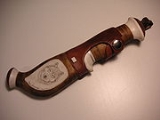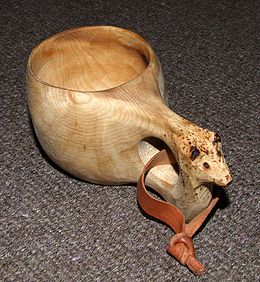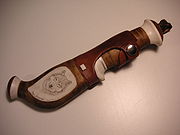
Duodji
Encyclopedia
Duodji is a centuries old Sami
handicraft
, that dates back to a time when the Sami were far more isolated from the outside world than they are today. Duodji tools and clothing accoutrements served their purpose to be functional and useful, however this does not mean that the Sami handicraft is unartistic. Sami doudji artists are able to bring function and art
together in such a delicate way to create beautiful works of art in their own right.
These functional items include, knives, cases, ladies bags, wooden cups, certain articles of clothing, etc. Duodji items were made and meant to be used in an everyday work environment.


and still carrying on the traditions of the Doudji. Although there have been slight changes in the traditional Duodji, today they are considered valuable pieces of art by collectors from all over the world. Some of the Duodji artists today are Olov Svonni, Martin Kuorak, Anders Sunna, Lars Pirak
and Per Olof Utsi.
, is of great cultural importance and is mainly used for weddings, funerals, confirmations and other cultural events. The gákti’s appearance differs from place to place and it tends to be longer in southern Sápmi than in the north. Traditionally leather, sinews, and wool was used to make the gákti, today however both velvet and silk can be used.
Sami people
The Sami people, also spelled Sámi, or Saami, are the arctic indigenous people inhabiting Sápmi, which today encompasses parts of far northern Sweden, Norway, Finland, the Kola Peninsula of Russia, and the border area between south and middle Sweden and Norway. The Sámi are Europe’s northernmost...
handicraft
Handicraft
Handicraft, more precisely expressed as artisanic handicraft, sometimes also called artisanry, is a type of work where useful and decorative devices are made completely by hand or by using only simple tools. It is a traditional main sector of craft. Usually the term is applied to traditional means...
, that dates back to a time when the Sami were far more isolated from the outside world than they are today. Duodji tools and clothing accoutrements served their purpose to be functional and useful, however this does not mean that the Sami handicraft is unartistic. Sami doudji artists are able to bring function and art
Applied art
Applied art is the application of design and aesthetics to objects of function and everyday use. Whereas fine arts serve as intellectual stimulation to the viewer or academic sensibilities, the applied arts incorporate design and creative ideals to objects of utility, such as a cup, magazine or...
together in such a delicate way to create beautiful works of art in their own right.
These functional items include, knives, cases, ladies bags, wooden cups, certain articles of clothing, etc. Duodji items were made and meant to be used in an everyday work environment.


Materials used
Traditionally Sami handicraft was divided into two sub-groups, men’s and women's handicraft. Men used mostly wood and antlers as well as other bones from reindeer when crafting, while women used leather and roots. The traditional Sami colours are red, green, blue and yellow.Well known Sami Duodji artists
Duodji artists are still active in SapmiSapmi
Sapmi can refer to:* Nation of the Sami people* Sápmi , the area where the Sami people live in northern Europe* A Sami cultural park located in Kárášjohka...
and still carrying on the traditions of the Doudji. Although there have been slight changes in the traditional Duodji, today they are considered valuable pieces of art by collectors from all over the world. Some of the Duodji artists today are Olov Svonni, Martin Kuorak, Anders Sunna, Lars Pirak
Lars Pirak
Lars Pirak was a Lule and North Sámi artist, yoiker and duodji master from Jokkmokk, Sweden. The Faculty of Arts at the University of Umeå conferred an Honorary Doctorate on Pirak in 2003 in recognition of his contribution to the Sámi culture.-Early life:Pirak was born to a family in the Tuorpon...
and Per Olof Utsi.
Gakti
The traditional costume, the gáktiGakti
Gakti or gákti, as it is written in Northern Sámi, is a piece of traditional clothing worn by the Sámi in northern areas of Norway, Sweden, Finland and the Kola Peninsula in Russia. The gákti is worn both in ceremonial contexts and while working, particularly when herding reindeer...
, is of great cultural importance and is mainly used for weddings, funerals, confirmations and other cultural events. The gákti’s appearance differs from place to place and it tends to be longer in southern Sápmi than in the north. Traditionally leather, sinews, and wool was used to make the gákti, today however both velvet and silk can be used.
External links
- Duodji at Design-Handverk http://www.design-handverk.no/Duodji.htm
- Doudji Institute: http://www.duodji.info/english/index.php?sladja=46 Retrieved Jan/29/2008
- Sameslöjdstiftelsen (Sami Duodji Association): http://www.sameslojdstiftelsen.com/?p=42 Retrieved Jan/29/2008

